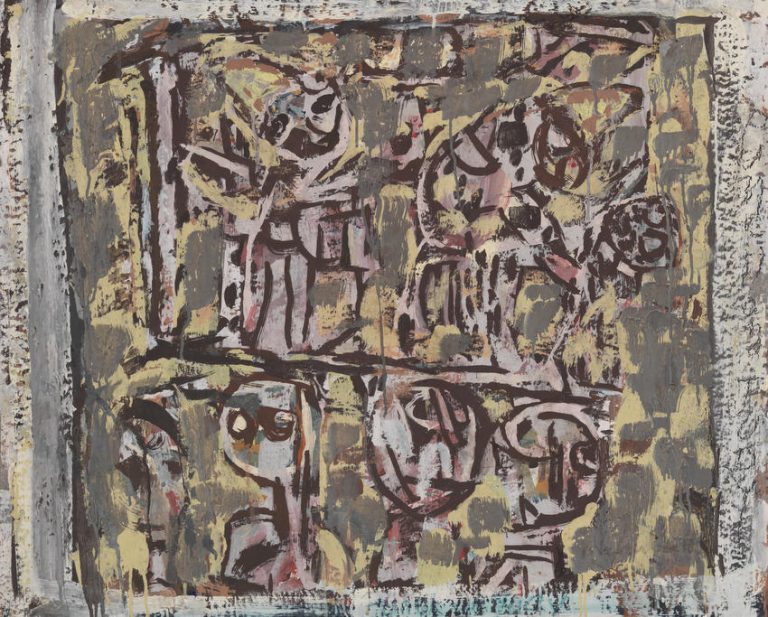We acknowledge the Traditional Owners of the land on which the Queensland Art Gallery | Gallery of Modern Art stands and recognise the creative contribution First Australians make to the art and culture of this country.

Ian Fairweather / Scotland/Australia 1891–1974 / Punch and Judy 1964 / Synthetic polymer paint and gouache on cardboard on composition board / 73 x 95cm / Gift of the Josephine Ulrick and Win Schubert Foundation for the Arts through the Queensland Art Gallery Foundation 2012. Donated through the Australian Government’s Cultural Gifts Program / Collection: Queensland Art Gallery | Gallery of Modern Art / © Ian Fairweather 1964/DACS. Licensed by Viscopy
Ian FairweatherPunch and Judy 1964
Not Currently on Display
Ian Fairweather painted Punch and Judy in 1964, a busy time for the artist as he was working on other major projects including the publication of his illustrated translation of The Drunken Buddha for the University of Queensland Press. Perhaps this Chinese classic of a Buddhist monk’s unorthodox behaviour made him think of European equivalents, like the anarchic traditional character of Punch.
This depiction of Judy’s misery has led the artist’s biographer, Murray Bail, to suggest that this painting may well be a self-portrait. Several other works of the period feature captured, trapped or cramped figures, and Fairweather had written the previous year of his detestation of the media: ‘one feels behind them a cynical manipulation pulling the strings, making the puppets posture’.
Ian Fairweather was born in Scotland in 1891. His father encouraged him to join the British Army and, in June 1914, just two months after he was commissioned, Fairweather was captured by the German Army and sent to a prison camp. There, he studied Japanese, sketched, and illustrated the prisoners’ magazine. After the war, he studied at the Slade School of Fine Art, London.
Leaving England in 1927, Fairweather travelled continually for nearly two decades, journeying to Canada, China, Indonesia, South America, the Philippines, Japan and Australia. In 1952, he attempted to cross the sea from Darwin to Timor on a raft, which turned into a perilous, 16-day solo journey that ended in Roti, Indonesia, from where he was deported to England.
When he returned to Australia in 1953, Fairweather retreated from society. He built a rudimentary hut on Bribie Island, north of Brisbane, and went on to produce his greatest works there until his death in 1974.
Discussion Questions
1. Look at this painting by Ian Fairweather from a distance, and as you gradually move in closer, discover how the rhythmic lines, blocks of colour and shapes on the canvas become figures within compartments. Count how many figures are hidden within Ian Fairweather’s brush marks and discuss their placement and posture.
2. Describe Fairweather’s use of colour, line and his portrayal of the figures in Punch and Judy.
Classroom Activities
Working in pairs, take turns at drawing each other on a large sheet of paper or cardboard. Make sure your drawings cover the full height and width of your working area. Set time limits of 2–5 minutes per drawing. As you make multiple drawings of each other on the same piece of paper, change the orientation of your sitter and overlap each drawing over the other.